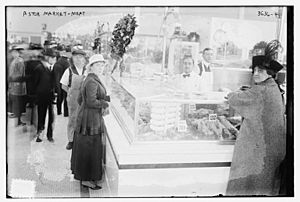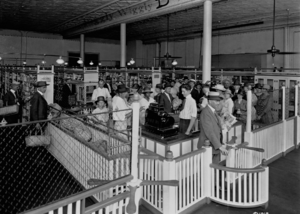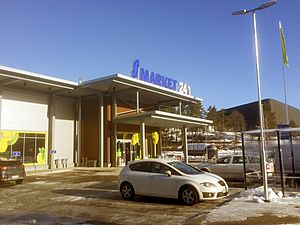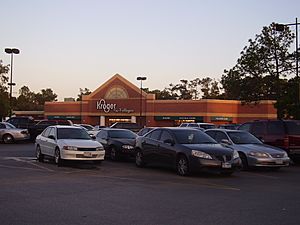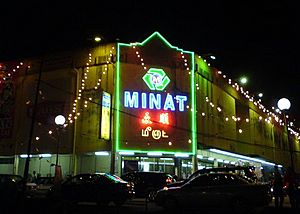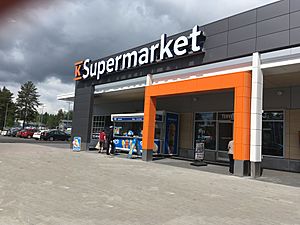Supermarket facts for kids
A supermarket is a big shop where you can find lots of different things. It's a place where you serve yourself, picking out food, drinks, and things for your home. Supermarkets are much bigger than old-fashioned grocery stores, but they are usually smaller than huge hypermarkets.
In a supermarket, you'll typically find fresh meat, fruits, vegetables, dairy items like milk and cheese, and baked goods. There are also shelves filled with canned foods, packaged snacks, and non-food items. You might find kitchenware, cleaning supplies, pharmacy products, and even pet food. Some supermarkets also sell clothes, DVDs, or seasonal items like Christmas decorations.
Sometimes, a very large supermarket that also sells many other things, like a department store, is called a hypermarket. Some supermarkets even have extra services like banks, cafes, or gas stations.
Supermarkets are usually big buildings on one level, often close to where people live. They offer many products in one place at pretty low prices. It's also easy to park, and many are open late or even 24 hours a day. Supermarkets often use advertising to attract shoppers.
To get people into their stores, supermarkets sometimes sell common items like bread or milk at a very low price. They make up for this by selling many other items. Because customers pick their own items and use self-checkouts, supermarkets save money on staff.
Contents
History of Supermarkets
A long time ago, in the 1920s, most food was sold in small corner grocery stores. In these stores, a clerk would get the items you wanted from shelves behind the counter. Most foods weren't packaged, so the clerk had to measure and wrap everything. Prices weren't always shown, so customers often had to bargain. This way of shopping was slow and needed many workers. People also had to visit different shops for meat, vegetables, bread, and fish.
An early idea for a large, affordable food market came from Vincent Astor in 1915. He opened the Astor Market in New York, which sold meat, fruit, and flowers. However, it was hard to get enough customers, and the market closed after two years.
The idea of a self-service grocery store, where customers pick their own items, was created by Clarence Saunders. He opened his first Piggly Wiggly store in 1916. His stores were very successful, and he even allowed others to open Piggly Wiggly stores as franchises.
There was a lot of discussion about which store was the first true supermarket. To settle this, experts defined a supermarket as having: self-service, separate sections for different products, low prices, and selling large amounts of goods. They decided that the first true supermarket in the United States was King Kullen. It was opened by Michael J. Cullen on August 4, 1930, in a former garage in New York City. King Kullen's motto was "pile it high and sell it cheap." All items had clear prices, so no bargaining was needed.
When the Great Depression hit in the 1930s, people needed cheaper food. Other big grocery chains like Kroger and Safeway Inc. started opening their own supermarkets. Kroger even built the first supermarket surrounded by a parking lot. This new way of shopping quickly spread across the country. Between 1936 and 1937, the number of supermarkets in the U.S. almost tripled! This made food much cheaper for families.
After World War II, as more people owned cars and moved to the suburbs, supermarkets grew even more. Many are now found in shopping centers.
In the United Kingdom, self-service stores took a bit longer to catch on. The first UK supermarket, Premier Supermarkets, opened in 1951. Over time, many smaller stores combined, leading to the big supermarket chains we see today, like Tesco and Sainsbury's.
In the 1950s, supermarkets gave out trading stamps as a reward for shopping. Today, most stores use "loyalty cards." These cards give you special discounts when you scan them at checkout.
Supermarkets today face competition from discount stores like Aldi and Lidl, which often have even lower prices. There are also warehouse clubs like Costco where you can buy items in bulk. These large stores have led to smaller local grocery stores closing down.
Online Supermarkets
In the 21st century, some supermarkets started selling groceries only online. One of the first successful online-only supermarkets was Ocado in the UK. They use lots of robots in their warehouses to prepare orders.
Many regular grocery stores now offer food delivery services, often using companies like DoorDash. Some even use delivery robots! To make online orders faster, supermarkets are building smaller warehouses called "micro-fulfillment centers" closer to customers.
Types of Supermarkets
Supermarkets come in different types, each with its own style:
- Traditional Supermarket: This is what most people think of as a supermarket. It sells a full range of groceries, meat, and produce. Examples include Kroger and Albertsons.
- Fresh Format: These stores focus on fresh foods like fruits, vegetables, and organic items. Examples are Whole Foods.
- Limited-Assortment Discount: These stores offer fewer items but at very low prices. Think of Aldi or Lidl.
- Super Warehouse: These are very large stores that combine a traditional supermarket with a warehouse store. They offer many items at reduced prices.
- Wholesale Club: You usually need a membership to shop here. They sell products in large sizes and bulk quantities, like Costco or Sam's Club.
- Supercenters: These are huge stores that combine a supermarket with a general merchandise store. They sell food, clothes, electronics, and more. Walmart Supercenters are a good example.
- Online-Only: These stores only exist online, and you order your groceries for delivery, like Amazon Fresh.
Eco-Friendly Supermarkets
Some supermarkets are now focusing on selling more organic foods. Others are trying to sell fewer products that use palm oil because its production can harm rainforests. Also, "zero waste" or "plastic-free" supermarkets are becoming more popular. They try to use less plastic packaging.
What You Find in a Supermarket
Large supermarkets sell many different items, often with many brands and sizes. Here are some common categories:
- Bakery: Bread, cakes, and pastries.
- Drinks: Juices, sodas, and sometimes alcohol.
- Non-Food & Pharmacy: Things like magazines, greeting cards, light bulbs, and basic medicines.
- Personal Care: Cosmetics, soap, and shampoo.
- Produce: Fresh fruits and vegetables.
- Floral: Flowers and plants.
- Deli: Sliced meats and cheeses.
- Prepared Foods: Ready-to-eat meals or frozen dinners.
- Meat & Seafood: Fresh or frozen meats and fish.
- Dairy: Milk, yogurt, cheese, and eggs.
- Center Store: Cleaning supplies, paper products, and packaged goods.
- Pet Supplies: Food and toys for animals.
How Supermarkets Are Designed
Supermarkets are carefully designed to make shopping easy and encourage you to buy more. Most products come already packaged and are placed on shelves in aisles. Items that need to stay cold are in special refrigerated cases.
The layout of a supermarket is planned to make you feel comfortable and to guide you through the store. For example, fresh produce is often placed at the front of the store to give a healthy, fresh feeling. Different sections, like the bakery or meat department, might have different flooring or lighting to make them feel like separate small shops within the larger supermarket.
Marketers use clever tricks to influence what you buy.
- Circulation: Supermarkets arrange products to control how you walk through the store. Items you need often, like bread and milk, are usually at the back. This makes you walk past many other products, which might make you buy things you didn't plan for.
- Coordination: Products are placed together in an organized way to boost sales. For example, toothpaste might be next to toothbrushes, and coffee near biscuits. This encourages you to buy related items.
- Convenience: The layout is designed to make shopping pleasant. Aisles are clear, and products are easy to find.
- Placement: Cheaper brands are often on the lowest shelves. Products for children are placed at their eye level. The most profitable brands are usually at adult eye level.
- Aisle Ends: The ends of aisles are very popular spots for products. Companies pay extra to have their items displayed there because they get a lot of attention and can lead to quick purchases.
- Checkout Displays: Small items like chocolates, magazines, and drinks are placed near the checkouts. This is to tempt you to buy something extra while you wait in line.
Criticisms of Supermarkets
- Because supermarkets are so big, they can put a lot of pressure on their suppliers and smaller local shops.
- Supermarkets can create a lot of food waste. However, new technologies are helping them manage their stock better and turn waste into energy.
See also
 In Spanish: Supermercado para niños
In Spanish: Supermercado para niños


